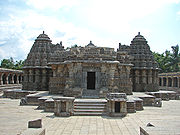
Keshava temple
Encyclopedia

Karnataka
Karnataka , the land of the Kannadigas, is a state in South West India. It was created on 1 November 1956, with the passing of the States Reorganisation Act and this day is annually celebrated as Karnataka Rajyotsava...
, is the last major temple of the Hoysala dynasty. Somnathpur is around 38 kilometers from Mysore, Karnataka
Karnataka
Karnataka , the land of the Kannadigas, is a state in South West India. It was created on 1 November 1956, with the passing of the States Reorganisation Act and this day is annually celebrated as Karnataka Rajyotsava...
state. The Keshava temple is the best-preserved most complete monument of Hoysala architecture. The temple is believed to have been built (around AD 1268) under Somnatha, a general in the army of Narasimha III
Narasimha III
Narasimha III . During his rule over the Hoysala Empire, internal feud between the king and his brother Ramanatha ruling from Kannanur came to the forefront. He also had to face invasions from the Seuna who attacked his regal capital. However, Narasimha III was able to inflict defeat on these...
.
Description
The entire temple was built on a broad platform to enable devotees to perform a pradakshinaPradakshina
Pradakshina or Pradakshinam , meaning circumambulation, consists of walking around in a 'circle' as a form of worship in Hindu ceremonies in India. The devotees walk around the sanctum sanctorum, the innermost chamber of the shrine housing the temple deity. It is done around sacred fire , trees and...
of the temple and to view the wonderful carvings on the outer wall surface. The platform on which the temple stands is guarded by seated lions. The actual temple base rises straight out of the platform and is composed of a series of bands that wind around the star form of the building. The shrines sit at the center of a courtyard bounded by a rectangular perimeter of cloisters and subsidiary shrines. An entrance pavilion is set into the east side of the courtyard.
In Hindu cosmology the universe is carried on the shoulders of powerful celestial guardian elephants. In these temples there are several elephants holding up the temple, which is symbolically a miniature universe. Each elephant is different in stance and poise and is beautifully bejeweled and decorated with chains and bells.
Every corner and angular projection of the central wall space of the temples is inhabited by familiar deities. They appear in all their glory, adorned with heavy jewels, towering crowns, bangles on every arm and chunky anklets on their feet.

